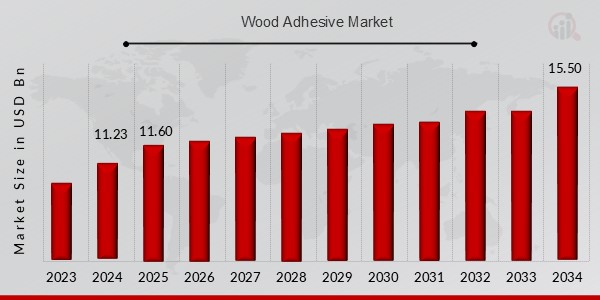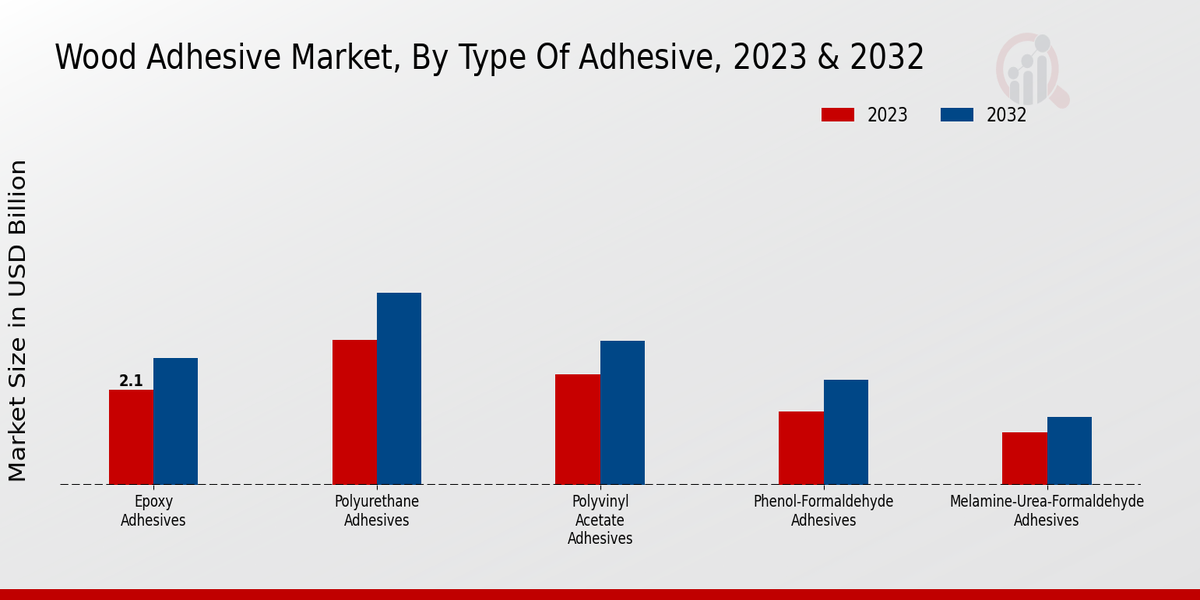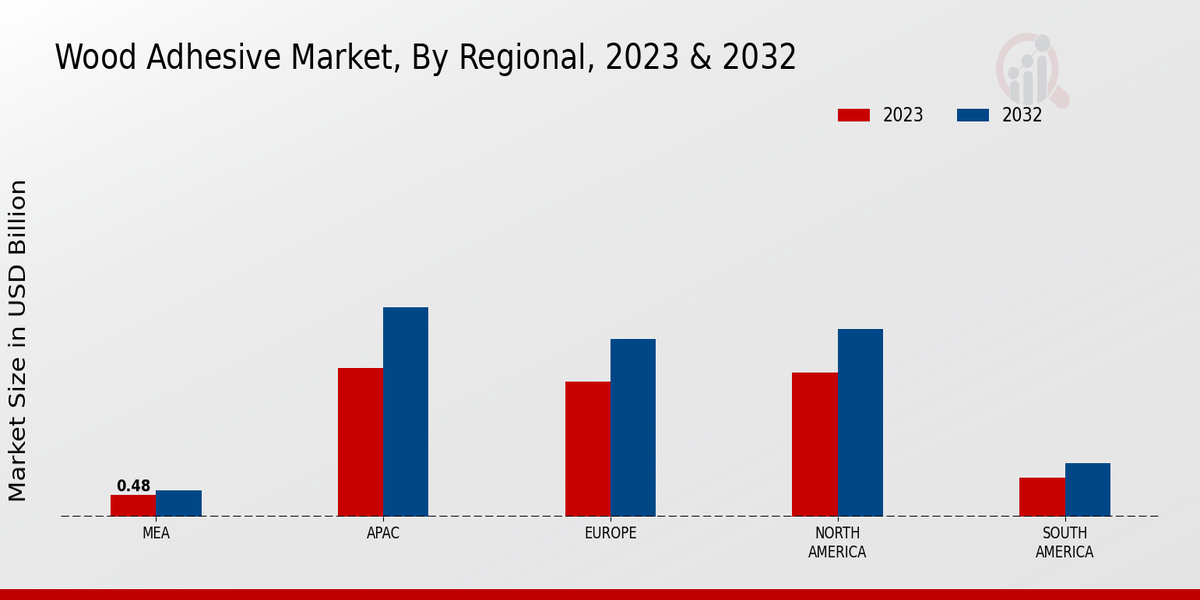Global Wood Adhesive Market Overview
The Wood Adhesive Market Size was estimated at 11.23 (USD Billion) in 2024. The Wood Adhesive Industry is expected to grow from 11.60(USD Billion) in 2025 to15.50 (USD Billion) by 2034. The Wood Adhesive Market CAGR (growth rate) is expected to be around 3.3% during the forecast period (2025 - 2034).
Key Wood Adhesive Market Trends Highlighted
The Wood Adhesive Market is primarily driven by construction and furniture industries’ preference for engineered wood products. While sustainable building processes are becoming popular, the industries are looking at meeting the environmental regulations, thus leading for the green adhesives consumption to be on the rise. This trend offers great prospects to be pursued and more particularly in the creation of adhesives that have renewable resources as raw material. Companies have begun funding R&D campaigns brought about by the need to develop bio-based adhesives which reduce the use of synthetic chemicals in other application of wood products.
Some of these trends have also reflected an escalation in the pace of adoption of technology in the formulation of the adhesives, which has led to improvement in the performance, durability, and functionality of the adhesive. In relation to VOC content, the fast growth of focus on master air quality and public demand and inclinations has factors over to liquid type and PU based adhesives considered to be healthy options.
Also, with the growth of the e-commerce sector, new opportunities have emerged for wood glue producers, driven by the popularity of furniture that can be assembled at home and requires efficient adhesives.
Due to continuing globalization, there is a wider scope within which the companies are operating as they seek to tap and make use of markets that are gradually improving due to urbanization.
This offers maelstrom value addition opportunities in the regions where the demand for construction materials is trailing and also in industries such as automotive and packaging which uses wood based components. All in all, further development in the market will be more active since it will respond to the preferences of consumers and regulatory requirements, which will promote sustainability and novelty.

Source: Primary Research, Secondary Research, Market Research Future Database and Analyst Review
Wood Adhesive Market Drivers
Increasing Construction and Furniture Manufacturing Activities
The Wood Adhesive Market Industry is significantly driven by the increasing activities in the construction and furniture manufacturing sectors. With the global population continuously rising, there is an ongoing demand for new housing, infrastructure, and commercial buildings. This surge in construction projects directly leads to an increased need for wood adhesives, which are essential for bonding various wood products used in flooring, cabinetry, and furniture.Additionally, the furniture industry is constantly evolving, with new designs and functionalities emerging, thereby further propelling the demand for innovative adhesive solutions.
As manufacturers strive to produce high-quality, durable wooden products, the specific requirements for adhesives grow in complexity, paving the way for advancements in wood adhesive formulations and applications. The compatibility of wood adhesives with various substrates also plays a crucial role in their utilization across various sectors.Furthermore, consumer preferences are shifting towards eco-friendly and sustainable products, pushing manufacturers to innovate wood adhesives that meet environmental standards. This transition adds another layer of growth potential to the Wood Adhesive Market Industry, as sustainable adhesive solutions are more sought after.
As the construction and furniture sectors continue to expand and adapt to modern preferences and needs, the demand for wood adhesives is expected to rise steadily in the coming years, contributing significantly to the overall market growth.
Rising Demand for Eco-friendly Adhesives
The Wood Adhesive Market Industry is witnessing a decisive shift towards eco-friendly adhesive products. As awareness regarding environmental sustainability increases among consumers and manufacturers alike, there is a growing demand for wood adhesives made from natural or low-toxicity components. Regulatory changes globally are also encouraging the adoption of adhesives that do not release harmful volatile organic compounds (VOCs) while maintaining strong bonding properties.This trend not only meets consumer preferences but also ensures compliance with environmental regulations, fostering growth in the sector.
Technological Advancements in Adhesive Formulations
Technological advancements are playing a vital role in shaping the Wood Adhesive Market Industry. The development of new adhesive formulations that offer better performance, durability, and bond strength is attracting attention from manufacturers in various industries. Innovations such as polyurethane-based adhesives, which provide water resistance and flexibility, are becoming popular. Additionally, the integration of nanotechnology in adhesive formulations is paving the way for stronger and lighter products, enhancing overall performance.
Wood Adhesive Market Segment Insights:
Wood Adhesive Market Type of Adhesive Insights
The Wood Adhesive Market has experienced noteworthy growth, particularly evident in its Type of Adhesive segment. This sector encompasses various adhesive types that cater to diverse applications in wood processing, enhancing product durability and performance. Among the different adhesive types, Polyurethane Adhesives held a significant market position, valued at 3.21 USD Billion in 2023 and projected to grow to 4.25 USD Billion by 2032. These adhesives are renowned for their excellent bonding strength and versatility, which makes them predominantly utilized in both residential and industrial applications.
Additionally, Polyvinyl Acetate Adhesives also showcase considerable market presence, starting from 2.45 USD Billion in 2023 and expected to reach 3.19 USD Billion by 2032. This adhesive type is favored for its easy application and good water resistance, making it a top choice for woodworking projects. Epoxy Adhesives, valued at 2.1 USD Billion in 2023 with a rise to 2.8 USD Billion in 2032, are also notably significant in the market due to their superior chemical resistance and strong adhesion properties.
These characteristics make them ideal for high-performance wood bonding applications, particularly in the automotive and aerospace industries, where precision and strength are paramount. Meanwhile, the Phenol-Formaldehyde Adhesives segment, with a valuation of 1.62 USD Billion in 2023 projected to grow to 2.33 USD Billion by 2032, captures attention for its use in producing plywood and laminated veneer lumber, showcasing its essential role in engineered wood products. Melamine-Urea-Formaldehyde Adhesives, although smaller in scale with a valuation of 1.15 USD Billion in 2023 increasing to 1.5 USD Billion by 2032, play a crucial role in the wood-based panels industry.
Their formulation enables enhanced durability and moisture resistance, making them valuable in furniture and cabinetry production. Each adhesive type not only contributes to the overall Wood Adhesive Market revenue but also demonstrates unique properties that cater to specific industry needs. The varying growth rates and market positions of these adhesive types highlight their diverse applications and the integral role they play in various sectors like construction, furniture, and automotive. Overall, the Wood Adhesive Market segmentation reflects a vibrant and evolving landscape within the industry, driven by trends favoring sustainable materials and innovations in adhesive technology.

Source: Primary Research, Secondary Research, Market Research Future Database and Analyst Review
Wood Adhesive Market Application Sector Insights
The Wood Adhesive Market sector shows a robust valuation of 10.53 USD Billion in 2023, reflecting the growing significance of wood adhesives in various applications. Among these, furniture manufacturing stands out due to its consistent demand for high-quality adhesives that enhance durability and aesthetics. The construction and renovation segment also plays a crucial role, driven by the ongoing infrastructure projects and home improvements that require reliable bonding solutions.
In woodworking, the necessity for precision and strength in product development makes wood adhesives indispensable.Meanwhile, the automotive industry increasingly relies on innovative adhesive technologies for weight reduction and improved performance of wooden components. Additionally, the musical instruments segment values quality adhesives for optimum sound and durability in production. The overall growth in these areas confirms the importance of the Wood Adhesive Market revenue while highlighting key trends such as sustainability and innovation, along with challenges such as fluctuating raw material prices.
As the market evolves, opportunities for advanced adhesive solutions will continue to rise, underscoring the dynamic nature of the Wood Adhesive Market industry.
Wood Adhesive Market Curing Mechanism Insights
The Wood Adhesive Market, valued at 10.53 USD billion in 2023, highlights the significance of the Curing Mechanism segment, which comprises different methodologies such as Hydrolytic, Thermal, UV Curing, and Moisture-Curing. Each mechanism plays a unique role in enhancing adhesive performance and application suitability within the industry. Hydrolytic curing processes are notably beneficial due to their effectiveness in moisture-rich environments, catering to a wide range of applications.
Thermal curing methods are important for their efficiency in various manufacturing processes, while UV curing demonstrates its rapid setting capabilities, making it highly favored in modern applications.Moisture-curing adhesives dominate within certain sectors, particularly in outdoor applications where exposure to humidity is prevalent. Overall, these mechanisms contribute significantly to the Wood Adhesive Market revenue, driven by trends toward sustainable materials and innovations in adhesive technology. With the market growth reflecting a consistent upward trend, driven by advancements and evolving user requirements, there are ample opportunities for innovations in the segment.
Wood Adhesive Market End User Insights
The Wood Adhesive Market is expected to reach a value of 10.53 billion USD in 2023, showcasing a diverse landscape driven by various end users. The market segmentation reveals that manufacturers and contractors play crucial roles in the demand for wood adhesives. Manufacturers leverage these adhesives for furniture, cabinetry, and flooring applications, benefiting from improved efficiencies and bonding properties.
On the other hand, contractors utilize wood adhesives for construction projects where structural integrity and durability are essential.Additionally, DIY enthusiasts are emerging as a significant segment, driven by the growing trend of home improvement projects, which fosters increased consumption of wood adhesives. As these end users continue to innovate and expand their applications, they collectively contribute to the steady growth of the Wood Adhesive Market, highlighting the importance of these segments in advancing market trends. Market growth is further supported by trends towards sustainable materials, as well as the adaptation of advanced technologies in adhesive formulations.
Wood Adhesive Market Formulation Insights
In 2023, the Wood Adhesive Market is expected to be valued at approximately 10.53 USD Billion, with a steady growth trend evident in the formulation segment. This segment comprises a diverse range of adhesives, notably Water-based, Solvent-based, and Reactive Adhesives. Water-based adhesives are increasingly favored due to their eco-friendly properties and ease of application, leading them to hold a significant share in the market.
Solvent-based adhesives maintain strong demand in industrial applications for their robust bonding capabilities, which makes them a popular choice in sectors requiring high-performance bonding solutions.Additionally, Reactive Adhesives are gaining traction for their unique curing properties that provide superior bond strength and durability. The Wood Adhesive Market data reveals that these formulations are driven by trends toward sustainability and performance enhancement, with growing opportunities in the furniture and construction industries. However, challenges such as regulatory compliance and competition from alternative bonding technologies may affect market dynamics.
Overall, the diverse formulation options play a crucial role in catering to various consumer needs, influencing the Wood Adhesive Market statistics and growth trajectory.
Wood Adhesive Market Regional Insights
The Regional segment of the Wood Adhesive Market is poised for growth, with the overall market valued at 10.53 USD billion in 2023. North America leads the market with a valuation of 3.1 USD billion in 2023, reflecting a significant demand for wood adhesives in construction and furniture manufacturing. Europe follows closely, valued at 2.9 USD billion, which highlights the region's substantial involvement in wood-based industries.
The Asia Pacific is also notable, with a market value of 3.2 USD billion, driven by rapid urbanization and an expanding furniture industry.South America and the Middle East Africa contribute smaller market sizes, valued at 0.85 USD billion and 0.48 USD billion respectively in 2023; however, both regions are being explored for their growth potential due to increasing demands for innovative building materials. Each region offers unique opportunities and challenges, influenced by local regulations, environmental concerns, and the increasing trend towards sustainable and eco-friendly adhesive solutions.
The Wood Adhesive Market revenue is supported by ongoing developments in technology and sustainable practices that allow for the production of high-performance adhesives suitable for various applications.

Source: Primary Research, Secondary Research, Market Research Future Database and Analyst Review
Wood Adhesive Market Key Players and Competitive Insights:
The Wood Adhesive Market is characterized by a diverse array of players competing across various segments such as construction, furniture manufacturing, and paper lamination. Companies in this market are focused on innovation and sustainability to meet the increasing demand for high-performance wood adhesives that provide durability, strength, and environmental compliance. With the rise of eco-friendly products, manufacturers are also exploring bio-based adhesives as an alternative to traditional synthetic options. The competitive landscape is marked by strategic partnerships, mergers and acquisitions, and ongoing research and development efforts aimed at enhancing product formulations and expanding market reach.
Market players are increasingly focusing on regional expansions and adapting to local needs, thus intensifying the competition within the sector.Huntsman has established itself as a formidable player in the Wood Adhesive Market, known for its wide range of adhesives that cater to different applications, particularly in wood-based products. The company emphasizes innovation and product quality, leveraging advanced technology to develop adhesives that enhance performance while minimizing environmental impact. Huntsman’s commitment to sustainable practices is reflected in their product offerings, which include low-emission adhesives suitable for various manufacturing processes.
The company’s robust distribution network and strong customer relationships allow it to maintain a competitive edge by ensuring efficient supply chains and responsive service. Huntsman continuously invests in research and development to stay ahead of market trends and meet the evolving demands of customers, ensuring its position as a trusted source in the wood adhesive sector.DuPont is another key participant in the Wood Adhesive Market, renowned for its pioneering chemistry and innovative adhesive solutions.
The company focuses on manufacturing durable and versatile adhesives that address the specific needs of the wood industry, offering high-performance products that contribute to the efficiency and reliability of wood assemblies. DuPont’s strong emphasis on research and technological advancements enables the development of adhesives that not only excel in performance but also comply with stringent environmental regulations. Moreover, DuPont leverages its extensive industry experience to create customized adhesive solutions, enhancing its appeal to a diverse array of clients across different sectors.
With a commitment to sustainability and performance, DuPont straddles the line between innovation and environmental responsibility, positioning itself as a leader in the wood adhesive market.
Key Companies in the Wood Adhesive Market Include:
Wood Adhesive Market Industry Developments
Recent developments in the Wood Adhesive Market have highlighted a growing trend towards eco-friendly and sustainable adhesive solutions. As environmental regulations become more stringent, manufacturers are increasingly focusing on bio-based adhesives derived from natural resources, which are expected to drive significant growth in the segment. Moreover, the rise in construction and furniture manufacturing activities in emerging economies is fueling demand for wood adhesives. Technological advancements in adhesive formulations are also being prioritized to enhance performance characteristics such as moisture resistance and bonding strength.
Additionally, strategic partnerships and collaborations among key players are aiming to expand product portfolios and improve market penetration. The ongoing shift towards digitalization and automation in manufacturing processes is expected to streamline production and reduce costs, further transforming the market landscape. As companies adapt to changing consumer preferences for sustainable products, the focus on innovation and sustainability is expected to shape the future trajectory of the wood adhesive industry.
Wood Adhesive Market Segmentation Insights
Wood Adhesive Market Type of Adhesive Outlook
- Polyvinyl Acetate Adhesives
- Melamine-Urea-Formaldehyde Adhesives
- Phenol-Formaldehyde Adhesives
Wood Adhesive Market Application Sector Outlook
- Construction and Renovation
Wood Adhesive Market Curing Mechanism Outlook
Wood Adhesive Market End User Outlook
Wood Adhesive Market Formulation Outlook
Wood Adhesive Market Regional Outlook
| Report Attribute/Metric |
Details |
| Market Size 2024 |
11.23 (USD Billion) |
| Market Size 2025 |
11.60(USD Billion) |
| Market Size 2034 |
15.50 (USD Billion) |
| Compound Annual Growth Rate (CAGR) |
3.3% (2025 - 2034) |
| Report Coverage |
Revenue Forecast, Competitive Landscape, Growth Factors, and Trends |
| Base Year |
2024 |
| Market Forecast Period |
2025 - 2034 |
| Historical Data |
2020 - 2024 |
| Market Forecast Units |
USD Billion |
| Key Companies Profiled |
Huntsman, DuPont, AkzoNobel, Franklin International, Kraton Corporation, Lord Corporation, Bostik, 3M, W.W. Grainger, Eastman Chemical, FANUC, Henkel, Sika, BASF, Scott Bader |
| Segments Covered |
Type of Adhesive, Application Sector, Curing Mechanism, End User, Formulation, Regional |
| Key Market Opportunities |
Sustainable product development Growing demand in furniture industry Expansion in construction sector Increasing preference for ecofriendly adhesives Technological innovations in adhesive formulations |
| Key Market Dynamics |
Increasing demand for sustainable materials Rising construction and furniture industries Technological advancements in adhesive formulations Stringent environmental regulations Growing ecommerce furniture sales |
| Countries Covered |
North America, Europe, APAC, South America, MEA |
Frequently Asked Questions (FAQ):
The Wood Adhesive Market is expected to be valued at 15.50USD Billion in 2034.
The anticipated CAGR for the Wood Adhesive Market from 2025 to 2034 is 3.3.
North America is projected to have the highest market value of 4.03 USD Billion in 2032.
The market value of Polyurethane Adhesives is expected to reach 4.25 USD Billion by 2032.
Key players in the market include Huntsman, DuPont, AkzoNobel, and Henkel, among others.
The Epoxy Adhesives segment is expected to be valued at 2.8 USD Billion in 2032.
The market size for the APAC region is expected to reach 4.5 USD Billion by 2032.
The Phenol-Formaldehyde Adhesives segment is projected to be valued at 2.33 USD Billion by 2032.
The market faces challenges related to raw material availability and strict regulations.
South America is expected to have a market size of 1.15 USD Billion by 2032.
















